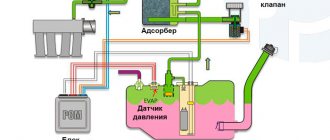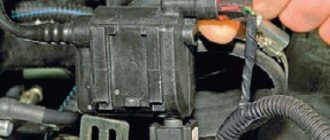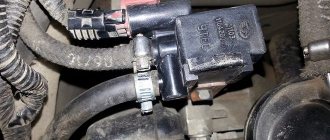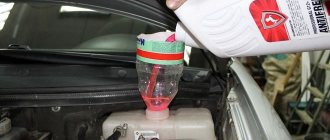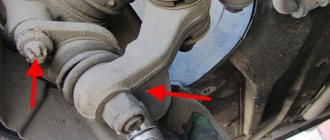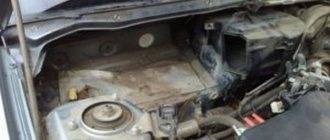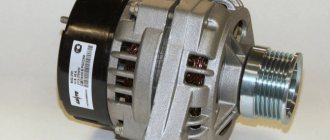Sometimes the very first signs of an adsorber malfunction can be completely unnoticeable, and sometimes they remind you of themselves with very characteristic symptoms. How can you tell if your car's adsorber has become damaged and requires repair? After reading our material, you will know more about adsorbers than ever before.
Signs of a malfunctioning adsorber are a “dark horse” for another reason. Even beginners know where the oil filter, carburetor, and battery are located in the car. But what is an adsorber? Where did this part come from, what role does it play in a modern car? After all, if you take into account domestic cars of previous years, they did not have any trace of adsorbers.
That’s right - the adsorber in the Soviet Union was a real curiosity. Today, with the advent of the Euro 3 standard, they began to install it on all modern cars. The basic task of the device is to retain the vapors of consumed fuel and do everything possible to ensure that as little harmful exhaust as possible enters the atmosphere. The rules of the standard are unshakable, so fulfilling it is an obligatory task for every car enthusiast. In connection with this fact, the adsorber began to be installed on foreign and domestic cars.
By the way, in some sources you can also find the name absorber. We are talking about the same device.
The appearance of the adsorber is somewhat reminiscent of an opaque jar. It is small in size and gases are adsorbed inside. The main adsorbent is coal, but some other substances can also be used. The spare part also has an electric valve. When working, it makes very characteristic sounds. When you warm up the engine, it begins to make a very characteristic clattering noise.
If we talk about adsorber malfunctions, they do not happen so rarely. Like any other part, the adsorber can become clogged with harmful impurities and become unusable. Other flaws are associated with minor or more serious mechanical damage, natural wear, and contamination of the gas-absorbing element.
Problem #1
– there is too much pressure in the gas tank. In fact, this is one of the main symptoms that something is wrong with your car's canister. The vapors have nowhere to go, so they begin to accumulate and put pressure on the gas tank. Even when the engine is not running, they do not want to escape through the adsorber. It is not difficult to verify the presence of strong pressure. Open the gas tank cap. If you hear a hissing sound, there is indeed a lot of vapor accumulated in the gas tank, which can be harmful to the atmosphere.
Naturally, you shouldn’t take every hissing sound as a serious problem. A light, barely noticeable hiss can still be taken as normal. According to modern environmental requirements, fuel systems must be strictly sealed. This allows you to minimize the release of vapors into the atmosphere.
Problem #2
– a sharp drop in speed. This happens if you start warming up the engine at 60 degrees, and it mercilessly stalls. In this situation, we can only advise one thing - check your adsorber again. It is possible that it is he who “spoils the weather.” To do this, disconnect the small hose that goes to the valve from the manifold. You will need to muffle it - for example, using a tie or plug. Start the engine again. If it continues to operate sluggishly and unstably, the adsorber is clogged.
Principle of operation
The adsorber itself allows fuel vapors to accumulate in a special place - the separator. As a result, gasoline turns into condensate and goes back to the tank. Vapors that have not undergone treatment go through double valves of the system, one of which prevents fuel from spilling out during an emergency (for example, a coup), and the second “is engaged” in regulating the pressure in the tank. The adsorber purge valve is located under the hood, and the adsorber itself is located on the tank. The control unit ensures the normal operation of the entire system: it ventilates and removes condensation.
Where is it installed?
As a rule, the adsorber is installed under the hood on the right in the direction of travel of the car, for example, in the VAZ 2110 it is in the form of a barrel.
In other cars, it can be square and installed to the left of the engine (in the direction of travel), under the air duct (Lada Granta), the vacuum brake booster (some Nissan models) or in the radiator area. For VAZ 2114 it is located near the battery and air filter.
On the Volkswagen Passat B3, the adsorber is located under the air filter on the right side in the direction of travel.
Other vehicles - see your model's owner's manual.
Design and operation of the adsorber purge valve
The KPA is an electromagnetic locking device that operates from the vehicle’s on-board network. The valve consists of:
- plastic case;
- valve with spring;
- windings;
- metal core;
- connector
When the vehicle's engine is turned off, no voltage is supplied to the valve and it remains in the closed position. That is, on the motor side, the system that captures vapors is blocked. At the same time, the adsorber begins to “collect” vapors. When the power unit starts, voltage is applied to the valve, causing it to open and fuel vapors to enter the intake manifold. As soon as the ignition is turned off, the control unit is de-energized and the pipeline is closed: no vapors enter the receiver.
Is it worth turning off the adsorber, pros and cons, possible consequences
Before turning off the adsorber in a car, it is important to understand how much this will affect the performance of the vehicle, including environmental ones, as well as driving safety.
In the article we will analyze the purpose and operating principle of the adsorber, where it is established, when it needs to be changed and whether it is possible to turn it off and drive without the device, how to properly remove it on a VAZ 2110, 2112, 2114, Lada Priora, Grant, Largus, Gazelle and whether it is necessary to flash the ECU after shutdown devices.
Signs of a malfunction of the control unit
First, start the engine: at idle or in cold weather, you will hear a characteristic, barely audible chirping sound. It indicates that the valve is working properly. In order not to confuse this sound with the noise from a working timing belt, sharply press the gas. The character of the chatter should not change. The following signs indicate a malfunction of the control unit:
- lighting of the CHECK signal on the instrument panel;
- determination of error PO441 during testing;
- increased gasoline consumption;
- unstable operation of the power unit when driving;
- unstable idle;
- increase in CO2 content;
- a hissing sound when unscrewing the tank lid (a vacuum has appeared);
- the appearance of a fuel smell in the cabin.
Malfunctions in the fuel vapor recovery system Lada Kalina
Since the solenoid valve itself is not a complex device, it has few malfunctions as such - it may not open or close when necessary, or may freeze in a certain position. But the culprit of the breakdown may not only be Evap-Solenoid; the gasoline vapor recovery system does not work correctly for other reasons:
- connecting pipes are pinched or clogged;
- normal vacuum is not created in the system;
- due to an open circuit, there is no voltage on the valve;
- the carbon filter is completely clogged (which is rare);
- The control unit malfunctions.
If the CPA is stuck in the open position and does not block the channel, the following defects may occur:
- the fuel mixture becomes richer, causing “blackness” to appear on the electrodes of the spark plugs;
- the engine begins to operate unstably, this is especially noticeable at idle;
- gasoline consumption increases;
- The throttle response of the internal combustion engine decreases.
When the EVAP channel is constantly blocked by the purge valve, excess vapor pressure is created in the gas tank, due to this:
- there is a risk of fuel pump failure;
- The fuel level sensor may fail.
Valve check on site
You will need a tester (voltmeter, multimeter) and a screwdriver. The KPA itself is installed on the radiator frame. The device can be recognized by seeing two tubes approaching it, through which the evaporation moves. Further:
- disconnect the electrical connector from the control unit by releasing the block lock;
- using a multimeter, check for the presence of voltage by touching the negative (black) probe of the device to ground, and the red probe to “A” (the letter on the block connector);
- turn on the ignition: the multimeter should show the vehicle's on-board voltage. If not, check the wiring.
Replacing the adsorber sensor and checking it
To check and replace the adsorber sensor on a Priora, you will need a multimeter and pieces of wire.
First, we remove and check the adsorber; to do this, prepare the car for work and, having released the latch, disconnect the wiring harness block from the purge valve. We connect the multimeter probe with the “-” sign to the car body (“ground”).
Finally, turn on the ignition and measure the voltage readings at terminal A of the wire bundle block. Each pin has its own designation, which is indicated on the block.
Please note that the voltage at the terminal must be below 12 V. If the voltage is not supplied to the block or it does not reach 12 V, therefore, the battery is discharged or the entire electronic control unit of the car is faulty.
To replace the adsorber valve on a Priora, turn off the ignition and move the valve up, thereby releasing the retainer. Then remove it from the bracket. To simplify assembly, mark the order of connecting the hoses to the valve with a marker.
Using a Phillips screwdriver, loosen the clamps and disconnect the hoses one by one. First the hose connecting to the adsorber, then the hose that connects to the throttle valve (housing). Finally, we replace the faulty adsorber sensor in the Priora.
How to check the adsorber valve removed from the car
You need to take a medical syringe of suitable volume, simply pull out the piston 2-3 cm and connect it to the outlet fitting. If you press on the piston, it will move with difficulty, which indicates that there is pressure in the valve. Now connect the battery to the electrical part of the control unit and press the piston again: the resistance should disappear. If this does not happen, you will have to buy a new valve.
A specific question is: how to check the operation of the adsorber valve? This device is found on many new cars. It is designed to absorb excess carbon gases from the car's gas tank. Thus, this mechanism prevents the release of gases into the atmosphere. It was necessary to use a device of this type after the introduction of new restrictive Euro-3 and higher standards. When working properly, the car has a low level of pollutant gases in the exhaust, and there is also a slight reduction in fuel consumption. However, like any device, this engine element also tends to break. Failure can occur due to clogging of the adsorbent inside the absorber, as well as due to direct mechanical impact on the absorber body. In any case, problems begin when the engine operates...
CONTENTS OF THE ARTICLE
First, a little definition.
What is the correct name for an adsorber or absorber?
Both concepts exist in the world. But despite the fact that from the Latin “sorbeo” and “absorbeo” are translated almost identically: adsorber - (from Latin ad - on, with and sorbeo - absorb), and absorber - (from Latin absorbeo - absorb), the semantic load both words convey different meanings.
- In our case, we are talking specifically about an adsorber, since this is a device that, with its solid surface, absorbs gaseous or soluble substances without undergoing chemical reactions. There are periodic and continuous devices.
- And an absorber is a device that completely absorbs gases (vapors) inside, followed by a chemical reaction, as a result of which one of the substances is completely absorbed by a special liquid (absorber).
Therefore, for our situation, the first option will be correct.
And now in more detail
How can I check the functionality of this device? An important element in the absorber is the valve. To understand the function, let's look at how the adsorber works. When the car is parked, a large amount of gasoline vapor can accumulate in its tank. Some of the vapor is caught by the recuperator, and the rest settles back into the tank. The part that was caught is sent to the adsorber. When the engine is running, the absorber valve closes and interrupts the access of vapors, now they are sent into the combustion chamber. Why is this necessary? When you start the car, our device prevents vapors from entering the exhaust manifold, thereby reducing the amount of harmful substances in the gas.
Standard adsorber for Priora - article number, device, price and location
The breather of the Priora car absorber is located on the top left relative to the engine cover. Replacing the absorber valve is not difficult, given that the instructions and steps are simple. Finding it is quite easy: the breather hose goes to the throttle to direct fuel in the desired direction.
Gasoline consumption will depend on the quality of its operation - the efficiency of the power system will decrease, since part of the engine vapor will be released into the atmosphere, as was the case in old cars. The VAZ-2170 catalog implies the presence of the following components in the “Gasoline Vapor Recovery System”:
- Breather (adsorber valve) - 2170-01164042-00, price - about 800 rubles.
- Hose 115 cm long - 2170-01164087-20, price - about 500 rubles.
- Hose 70 cm long - 2108-31164103-10, cost - 350 rubles.
- Hose 90 cm long - 2110-31164109-12, cost - 400 rubles.
- Hose 25 cm long - 2110-31164105-12, cost - 150 rubles.
- Steam removal tube – 2170-01164084-01 – 150 rub.
- Front steam exhaust pipe – 2170-01164244-01 – 200 rub.
- Tube – 2170-01164282-00 – 300 rub.
- Adsorber – 2170-01164010-00 – 800 rub.
- Separator – 2170-01164005-01 – 1500 rub.
- Middle steam outlet tube - 2170-01164248-00 - 300 rubles.
How to identify a problem at work?
The most common symptoms of malfunction include:
1) Sometimes the engine starts to run unstable at idle speed;
2) If clogged, you may feel a slight increase in fuel consumption;
3) The car engine does not start the first time when hot;
4) A noticeable loss of traction at low speeds. At higher speeds, the loss of torque is less sensitive.
Another common malfunction is the appearance of cracks in rubber plugs. Through these cracks (holes), additional air is sucked in, and as a result, leads to problems with the engine.
Why do they refuse the adsorber?
Despite the advantages of this design solution, and these are: fuel economy, absence of odor in the cabin, reduction of harmful emissions into the atmosphere (although many do not care about this), the adsorber has a number of significant drawbacks, due to which many seek to disable it or completely remove it.
Disadvantages, they are also signs of malfunction:
- Expensiveness of the product (not for all cars). Replace or remove? More often, preference is given to the second option. For example, on an Acura MDX the price of the product varies within 10,000 rubles. For VAZ – from 800 rubles.
- A malfunction of the device leads to interruptions in the operation of the unit: the engine does not pull (poor acceleration of the car, stalls when driving uphill, transporting goods, floating idle speed on a warm engine, if the tank is plastic, then with a clogged adsorber, constantly compressing and unclenching (in the absence of a bypass valve in the lid), it may eventually burst due to the pressure of gasoline vapors; if it is metal, then it will become deformed. One of the characteristic signs of a malfunctioning adsorber is a hissing sound when the fuel tank lid is opened, caused by the movement of air into the tank (not out) and the appearance of the smell of gasoline in the cabin, incorrect fuel level.The appearance of error p0443 (the cause of the error is a clogged or faulty solenoid valve).
Therefore, when a product fails, many people turn it off and remove it, or take a more complicated path - they open the case and replace the old activated carbon with a new one.
Why was the adsorber created?
Actually, this is a tribute to the environmental standard, namely EURO-2. Essentially this is a large filter that catches light hydrocarbons. According to the new standards, it is unacceptable for gasoline vapors to enter the atmosphere, because this contributes to air pollution.
Also, couples should not enter the car interior, because this is, to put it mildly, harmful! ON old carburetor cars, such a filter and its valve simply did not exist; the system there is a little different. BUT the carburetor went away along with the old standards, now there is only an injector and a filtration system is MANDATORY.
Do-it-yourself absorber valve replacement
If signs of malfunction are detected, the valve will need to be repaired or replaced. The adsorber valve is inexpensive and easy to replace. To dismantle you need to have a pair of Phillips screwdrivers and know where the canister purge valve is located. Operating procedure:
The markings on the old and new valves must match.
- Open the hood and find a cylindrical device - an adsorber.
- Remove the negative terminal from the battery.
- Disconnect the wire block by pressing the latch and pulling it towards you.
- Loosen the valve.
- Remove the fittings under the latch and disconnect the hoses.
- Remove the valve together with the bracket from the adsorber.
- The new valve is installed in the reverse order.
Thus, even such a small element as the adsorber valve performs important functions and its malfunction can seriously disrupt the operation of the entire engine. Therefore, it is important to monitor the condition of your car and carry out diagnostics on time.

